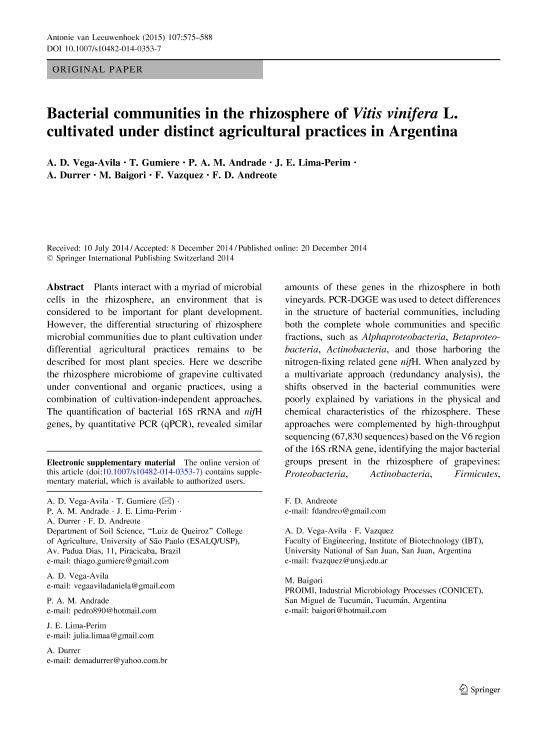Mostrar el registro sencillo del ítem
dc.contributor.author
Vega Avila, Angela Daniela

dc.contributor.author
Gumiere, T.
dc.contributor.author
Andrade, P. A. M.
dc.contributor.author
Lima Perim, J. E.
dc.contributor.author
Durrer, A.
dc.contributor.author
Baigori, Mario Domingo

dc.contributor.author
Vazquez, Fabio

dc.contributor.author
Andreote, F. D.
dc.date.available
2017-12-04T17:14:53Z
dc.date.issued
2015-02
dc.identifier.citation
Vega Avila, Angela Daniela; Gumiere, T.; Andrade, P. A. M.; Lima Perim, J. E.; Durrer, A.; et al.; Bacterial communities in the rhizosphere of Vitis vinifera L. cultivated under distinct agricultural practices in Argentina; Springer; Antonie van Leeuwenhoek; 107; 2; 2-2015; 575-588
dc.identifier.issn
0003-6072
dc.identifier.uri
http://hdl.handle.net/11336/29569
dc.description.abstract
Plants interact with a myriad of microbial cells in the rhizosphere, an environment that is considered to be important for plant development. However, the differential structuring of rhizosphere microbial communities due to plant cultivation under differential agricultural practices remains to be described for most plant species. Here we describe the rhizosphere microbiome of grapevine cultivated under conventional and organic practices, using a combination of cultivation-independent approaches. The quantification of bacterial 16S rRNA and nifH genes, by quantitative PCR (qPCR), revealed similar amounts of these genes in the rhizosphere in both vineyards. PCR-DGGE was used to detect differences in the structure of bacterial communities, including both the complete whole communities and specific fractions, such as Alphaproteobacteria, Betaproteobacteria, Actinobacteria, and those harboring the nitrogen-fixing related gene nifH. When analyzed by a multivariate approach (redundancy analysis), the shifts observed in the bacterial communities were poorly explained by variations in the physical and chemical characteristics of the rhizosphere. These approaches were complemented by high-throughput sequencing (67,830 sequences) based on the V6 region of the 16S rRNA gene, identifying the major bacterial groups present in the rhizosphere of grapevines: Proteobacteria, Actinobacteria, Firmicutes, Bacteriodetes, Acidobacteria, Cloroflexi, Verrucomicrobia and Planctomycetes, which occur in distinct proportions in the rhizosphere from each vineyard. The differences might be related to the selection of plant metabolism upon distinct reservoirs of microbial cells found in each vineyard. The results fill a gap in the knowledge of the rhizosphere of grapevines and also show distinctions in these bacterial communities due to agricultural practices.
dc.format
application/pdf
dc.language.iso
eng
dc.publisher
Springer

dc.rights
info:eu-repo/semantics/openAccess
dc.rights.uri
https://creativecommons.org/licenses/by-nc-sa/2.5/ar/
dc.subject
Bacterial Communities
dc.subject
Cultivation
dc.subject
Cultivationindependent
dc.subject
Plant?Microbe Interactions
dc.subject
Rhizosphere Microbiome
dc.subject
Organic Management
dc.subject.classification
Meteorología y Ciencias Atmosféricas

dc.subject.classification
Ciencias de la Tierra y relacionadas con el Medio Ambiente

dc.subject.classification
CIENCIAS NATURALES Y EXACTAS

dc.title
Bacterial communities in the rhizosphere of Vitis vinifera L. cultivated under distinct agricultural practices in Argentina
dc.type
info:eu-repo/semantics/article
dc.type
info:ar-repo/semantics/artículo
dc.type
info:eu-repo/semantics/publishedVersion
dc.date.updated
2017-11-09T20:32:46Z
dc.journal.volume
107
dc.journal.number
2
dc.journal.pagination
575-588
dc.journal.pais
Alemania

dc.journal.ciudad
Berlin
dc.description.fil
Fil: Vega Avila, Angela Daniela. Universidad Nacional de San Juan. Facultad de Ingeniería. Instituto de Biotecnología; Argentina. Universidade Do Sao Paulo. Escola Superior de Agricultura Luiz de Queiroz Esalq; Brasil. Consejo Nacional de Investigaciones Científicas y Técnicas; Argentina
dc.description.fil
Fil: Gumiere, T.. Universidade Do Sao Paulo. Escola Superior de Agricultura Luiz de Queiroz Esalq; Brasil
dc.description.fil
Fil: Andrade, P. A. M.. Universidade Do Sao Paulo. Escola Superior de Agricultura Luiz de Queiroz Esalq; Brasil
dc.description.fil
Fil: Lima Perim, J. E.. Universidade Do Sao Paulo. Escola Superior de Agricultura Luiz de Queiroz Esalq; Brasil
dc.description.fil
Fil: Durrer, A.. Universidade Do Sao Paulo. Escola Superior de Agricultura Luiz de Queiroz Esalq; Brasil
dc.description.fil
Fil: Baigori, Mario Domingo. Consejo Nacional de Investigaciones Científicas y Técnicas. Centro Científico Tecnológico Conicet - Tucuman. Planta Piloto de Procesos Industriales Microbiologicos; Argentina
dc.description.fil
Fil: Vazquez, Fabio. Universidad Nacional de San Juan. Facultad de Ingeniería. Instituto de Biotecnología; Argentina
dc.description.fil
Fil: Andreote, F. D.. Universidade Do Sao Paulo. Escola Superior de Agricultura Luiz de Queiroz Esalq; Brasil
dc.journal.title
Antonie van Leeuwenhoek

dc.relation.alternativeid
info:eu-repo/semantics/altIdentifier/doi/https://dx.doi.org/10.1007/s10482-014-0353-7
dc.relation.alternativeid
info:eu-repo/semantics/altIdentifier/url/https://link.springer.com/article/10.1007%2Fs10482-014-0353-7
Archivos asociados
